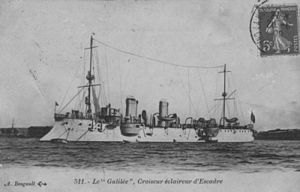 Galilée at anchor sometime before 1909
| |
| Class overview | |
|---|---|
| Name | Linois class |
| Builders | |
| Operators | |
| Preceded by | Friant class |
| Succeeded by | Descartes class |
| Built | 1892–1898 |
| In commission | 1895–1920 |
| Completed | 3 |
| Retired | 3 |
| General characteristics (data for Linois) | |
| Type | Protected cruiser |
| Displacement | 2,285 to 2,318 long tons (2,322 to 2,355 t) |
| Length | 98 m (321 ft 6 in) (o/a) |
| Beam | 10.62 m (34 ft 10 in) |
| Draft | 5.44 m (17 ft 10 in) |
| Installed power |
|
| Propulsion | |
| Speed | 20.5 knots (38.0 km/h; 23.6 mph) |
| Complement | 250–269 |
| Armament |
|
| Armor |
|
The Linois class comprised three protected cruisers of the French Navy built in the early 1890s; the three ships were Linois, Galilée, and Lavoisier. They were ordered as part of a naval construction program directed at France's rivals, Italy and Germany, particularly after Italy made progress in modernizing its own fleet. The plan was also intended to remedy a deficiency in cruisers that had been revealed during training exercises in the 1880s. As such, the Linois-class cruisers were intended to operate as fleet scouts and in the French colonial empire. The ships were armed with a main battery of four 138.6 mm (5.46 in) guns supported by two 100 mm (3.9 in) guns and they had a top speed of 20.5 knots (38.0 km/h; 23.6 mph).
All three members of the class served with the Mediterranean Squadron upon entering service in the mid-to-late 1890s. During this period, they were primarily occupied with peacetime training maneuvers. Lavoisier was transferred to the Newfoundland and Iceland Naval Division in 1903, where she patrolled fisheries for the next decade. After uneventful careers, Linois and Galilée were discarded in 1910 and 1911, respectively, having spent less than fifteen years in service. Lavoisier was the only member of the class still in commission at the start of World War I in August 1914, and she was used to patrol for German warships and submarines in various secondary theaters, ending the war in the Syrian Naval Division, where she remained through the end of the war. She was ultimately struck from the naval register in 1920 and thereafter broken up.